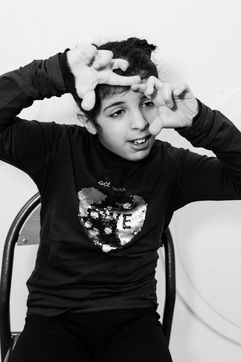Pour accéder à la série en entier, vous devez vous logger ou demander un compte Hans Lucas en cliquant ici.
« HORS NORMES » Portraits de jeunes en situation de handicap qui cassent les codes du portrait scolaire.
Chaque année, en France, tous les enfants scolarisés font leur photo scolaire. Un photographe professionnel se déplace au sein de l'établissement et réalise des portraits des élèves ainsi qu'une photo de groupe.
Dans les établissements spécialisés qui accueillent des enfants en situation de handicap, comme les Instituts médicaux Educatifs, par exemple, cette pratique est loin d'être courante et régulière. Pourquoi un enfant en situation de handicap ne pourrait-il pas avoir son portrait chaque année ainsi qu'une photo de son groupe afin de garder un souvenir de son année au sein de l'établissement dans lequel il est pris en charge ? Les parents n'ont-ils pas envie d'avoir la photo de leur enfant handicapé en porte-clé, marque page ou simplement accrochée au frigo, comme pour leurs autres enfants ?
La demande des familles est pourtant là mais les établissements se heurtent parfois à des photographes qui ne savent pas comment procéder face à ce public à qui on ne peut pas demander de s'assoir sagement et de sourire.
Etant mère d'une fille polyhandicapée, j'étais moi-même confrontée au manque de photo « scolaire » pour ma fille, avec un sentiment d'injustice.
Depuis 2017, photographier les personnes en situation de handicap est devenu mon combat. Elles sont malheureusement trop peu visibles sur internet et quasi inexistantes des réseaux sociaux et sites des photographes professionnels. De mon point de vue, à chaque fois qu'une personne handicapée est photographiée, c'est bien souvent son handicap qui est au premier plan plutôt que la personne elle-même. Pourtant, le handicap ne définit pas l'homme, la femme ou l'enfant concerné. C'est pourquoi je m'efforce à retranscrire le mieux possible les valeurs de la personne que je photographie, peu importe son handicap. En famille, je pose mon attention sur les liens et l'amour qui unit chaque membre. Ma fille est ma muse et m'inspire chaque jour pour porter un autre regard sur le handicap.
J'ai donc commencé à intervenir dans les établissements spécialisés pour photographier leurs jeunes en situation de handicap. Ma démarche était de laisser l'enfant être lui-même et de me donner ce qu'il souhaite. Peu importe l'attitude, l'émotion et le regard ou non face caméra. Je souhaitais également leur donner une place où s'exprimer et leur donner le droit à l'image. J'ai fais le choix de réaliser ces portraits en noir et blanc pour aller à l'essentiel.
"HORS NORMES" Portraits of young people with disabilities that break the codes of school portraits.
Every year in France, all school children have their school photo taken. A professional photographer comes to the school and takes portraits of the pupils as well as a group photo.
In specialised schools for children with disabilities, such as medical and educational institutes, for example, this practice is far from common and regular. Why shouldn't a child with a disability have his or her portrait taken every year, as well as a photo of his or her group, to keep a souvenir of his or her year in the institution where he or she is being cared for? Wouldn't parents like to have a photo of their disabled child on a key ring, bookmark or simply hanging on the fridge, like their other children?
The demand from families is there, but the establishments sometimes come up against photographers who do not know how to proceed when faced with this public who cannot be asked to sit quietly and smile.
As the mother of a multi-disabled daughter, I myself was confronted with the lack of a "school" photo for my daughter, with a feeling of injustice.
Since 2017, photographing people with disabilities has become my struggle. Unfortunately, they are too little visible on the internet and almost non-existent on social networks and professional photographers' websites. From my point of view, every time a disabled person is photographed, it is often their disability that is in the foreground rather than the person themselves. However, the disability does not define the man, woman or child concerned. That is why I try to capture the values of the person I am photographing as best I can, regardless of their disability. In families, I focus on the bonds and love that unite each member. My daughter is my muse and inspires me every day to look at disability differently.
I therefore started to intervene in specialised establishments to photograph their young people with disabilities. My approach was to let the child be himself and to give me what he wanted. It doesn't matter what attitude, emotion and look they have in front of the camera or not. I also wanted to give them a place to express themselves and give them the right to the image. I chose to make these portraits in black and white to get to the essence.









